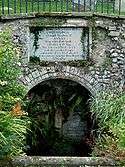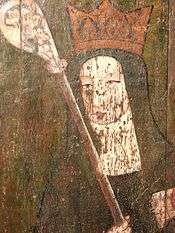Wihtburh
| Saint Withburga | |
|---|---|
|
St. Wihtburh, depicted in a rood screen in Dereham | |
| Virgin; Abbess | |
| Born | Unknown |
| Died |
17 March 743 Dereham, England |
| Venerated in | Roman Catholic Church; Anglican Communion; Eastern Orthodoxy |
| Feast | 8 July |
Wihtburh (or Withburga) (died 743) was an East Anglia saint, princess and abbess who was possibly a daughter of Anna of East Anglia, located in present-day England. She founded a monastery at Dereham in Norfolk. A traditional story says that the Virgin Mary sent a pair of female deer to provide milk for her workers during the monastery's construction. Withburga's body is supposed to have been uncorrupted when discovered half a century after her death: it was later stolen on the orders of the abbot of Ely. A spring appeared at the site of the saint's empty tomb at Dereham.
Family
Tradition describes Wihtburh as the youngest of the daughters of Anna of East Anglia, but she is not mentioned by Bede. He was well-informed about and described her elder sisters[1] Seaxburh of Ely, Æthelthryth and Æthelburh of Faremoutiers and Sæthryth, her older half-sister.[2]
Legend of Saint Wihtburh and the does
After her father's death (c.653), Wihtburh built a convent in East Dereham, Norfolk. A traditional story relates that while she was building the convent, she had nothing but dry bread to give to the workmen. She prayed to the Virgin Mary and was told to send her maids to a local well each morning. There they found two wild does which were gentle enough to be milked; they provided nutritious drink for the workers. This allowed the workers to be fed.[3]
The local overseer did not like Wihtburh or her miracles. He decided to hunt down the does with dogs and prevent them from coming to be milked. He was punished for his cruelty when he was thrown from his horse and broke his neck. This story is commemorated in the large town sign in the centre of East Dereham.
Events following Wihtburh's death

Wihtburh died in 743 and was buried in the cemetery of Ely abbey.[4] When her body was dug up 55 years later, it was found not to have decayed. This was considered a miracle and her remains were reinterred in the church which she had built in Dereham. The church became a place of pilgrimage, with people visiting Wihtburh's tomb.
In 974 Brithnoth, the abbot of Ely, elected to steal her body so that he could profit from the pilgrims' visits. Brithnoth and some armed men went to Dereham and organised a feast. When the Dereham men were properly drunk, the Ely mob stole Withburga's body and set off for home. Dereham men soon found out that this crime had taken place and set off after the Ely criminals.[5]
The two sides had a pitched fight, using spears as well as fists. As the men approached Ely, however, the thieves had the advantage of knowing their way through the swamps and marshes. They were successful at reinterring Wihtburh in Ely.
When the Dereham men returned home, they discovered that a spring had arisen in Wihtburh's violated tomb. The water in this spring was considered to be compensation for the loss of their saint; pilgrims continued to come and now could drink from the water. The spring has never run dry. The water in Withburga's tomb can be visited to this day.
References
Sources
- Blanton, Virginia (2004). "King Anna's Daughters: Genealogical Narrative and Cult Formation in the 'Liber Eliensis'". Historical Reflections / Réflexions Historiques. 30 (1): 127–149. JSTOR 41299300.
- Norfolk and Norwich Archaeological Society. "Norfolk and Norwich Archaeological Society, vol. 3 (1852)". Retrieved 2010-05-31.
- Yorke, Barbara (2002). Kings and Kingdoms of Early Anglo-Saxon England. London and New York: Routledge. ISBN 0-415-16639-X.
